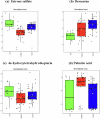Untargeted metabolomics reveals key pathways in miscarriage: steroid, folate, fatty acid & glycosaminoglycan metabolism
- PMID: 40519213
- PMCID: PMC12165837
- DOI: 10.1038/s44294-025-00085-9
Untargeted metabolomics reveals key pathways in miscarriage: steroid, folate, fatty acid & glycosaminoglycan metabolism
Abstract
Metabolites influencing miscarriage outcomes remain understudied. We hypothesized that aberrant metabolism impacts threatened miscarriage outcomes and that understanding these pathways could offer new management strategies. This case-control study analyzed serum metabolomics from 80 women between 5 and 12 weeks' gestation at KK Women's and Children's Hospital, Singapore, comparing three groups: women with threatened miscarriage who miscarried (TMMC), those with ongoing pregnancies (TMO), and women with normal pregnancies (NP). Using untargeted liquid chromatography-mass spectrometry and pathway analysis through MetaboAnalyst 5.0 and the Kyoto Encyclopedia of Genes and Genomes, 267 metabolites across 12 enriched pathways were identified. Dysregulations in steroid (AUC 0.82), folate (AUC 0.59), fatty acid (AUC 0.70), and glucosaminoglycan (AUC 0.64) pathways distinguished women who miscarried from those with ongoing pregnancies (TMMC vs TMO). We provide initial insights into the metabolic profile associated with miscarriage, highlighting disruptions in steroid hormone, fatty acid, folate, and glucosaminoglycan biosynthesis. Further validation may support biomarker development for prognostication.
Keywords: Reproductive biology; Reproductive disorders.
© The Author(s) 2025.
Conflict of interest statement
Competing interestsThe authors declare no competing interests.
Figures



Similar articles
-
Serum progesterone distribution in normal pregnancies compared to pregnancies complicated by threatened miscarriage from 5 to 13 weeks gestation: a prospective cohort study.BMC Pregnancy Childbirth. 2018 Sep 5;18(1):360. doi: 10.1186/s12884-018-2002-z. BMC Pregnancy Childbirth. 2018. PMID: 30185145 Free PMC article.
-
[Screening of serum oxysterol biomarkers for colon cancer by liquid chromatography-tandem mass spectrometry].Se Pu. 2022 Jun;40(6):541-546. doi: 10.3724/SP.J.1123.2022.01001. Se Pu. 2022. PMID: 35616199 Free PMC article. Chinese.
-
Untargeted metabolomics analysis of glycerophospholipid metabolism in very low birth weight infants administered multiple oil lipid emulsions.BMC Pediatr. 2024 Dec 31;24(1):849. doi: 10.1186/s12887-024-05343-4. BMC Pediatr. 2024. PMID: 39736612 Free PMC article.
-
Untargeted metabolomics analysis of esophageal squamous cell cancer progression.J Transl Med. 2022 Mar 14;20(1):127. doi: 10.1186/s12967-022-03311-z. J Transl Med. 2022. PMID: 35287685 Free PMC article. Review.
-
Folic acid supplementation and malaria susceptibility and severity among people taking antifolate antimalarial drugs in endemic areas.Cochrane Database Syst Rev. 2022 Feb 1;2(2022):CD014217. doi: 10.1002/14651858.CD014217. Cochrane Database Syst Rev. 2022. PMID: 36321557 Free PMC article.
References
-
- Mouri, M., Hall, H. & Rupp, T. J. Threatened Miscarriage. In StatPearls (StatPearls Publishing, 2025). Available at https://www.ncbi.nlm.nih.gov/books/NBK430747/. - PubMed
-
- Kuehn, B. M. More Comprehensive Care for Miscarriage Needed Worldwide. JAMA325, 2335 (2021). - PubMed
-
- Smith, K. E. & Buyalos, R. P. The profound impact of patient age on pregnancy outcome after early detection of fetal cardiac activity. Fertil. Steril.65, 35–40 (1996). - PubMed
LinkOut - more resources
Full Text Sources
Miscellaneous
